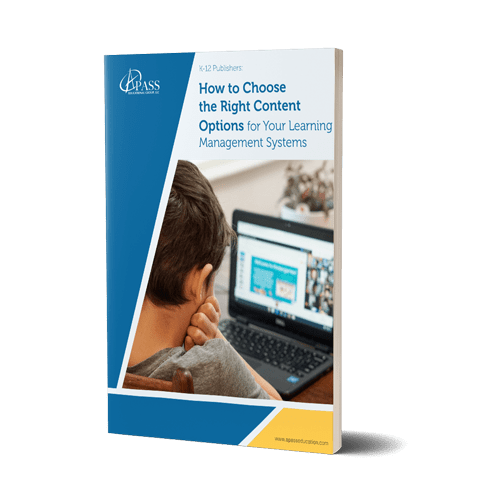The pandemic has opened various pathways for K-12 students to learn. Savvy providers think differently about the digital tools they offer schools. Publishers give districts digital solutions for different scenarios students face. Also, leaders create equity by meeting the student where they are in their learning journey. Publishing leaders can create materials to supply these virtual platforms, giving every student an equal opportunity in K-12 schools.
Providers Supply a K-12 School With Out-of-District Content
All students need access to prep courses they need for college or career pathways. So, providers can give students courses their school does not offer. A single student can enroll in an advanced math class. Or, an entire grade can take a virtual foreign language class with a qualified instructor. Also, publishers can make additional tools that let students practice skills. So, digital tools can help districts when a teacher shortage exists.
Publishing Leaders Direct Teams to Establish Fast Tracks
Likewise, publishers can set up fast tracks for students to accelerate their education. The fast track works for students eying early college or career certification courses. This tactic lets a student take multiple classes online for a pathway. Also, providers can use assessment and testing to determine if the student meets the requirements. Besides that, providers can offer schools live tutors or a tutoring service to support a curriculum. Therefore, live tutors can aid students in many scenarios.
Create K-12 School Materials for Various Virtual Scenarios
Students homebound due to illness can learn by accessing virtual materials. Student-athletes could take virtual classes on the road. Districts can meet the student’s IEP needs. Providers’ tools let students participate in a class for different circumstances. Also, publishers give schools flexibility to meet individualized and personalized learning needs.
Meet Individualized and Personalized Learning Needs for a K-12 School
The most innovative tool publishers furnish K-12 schools will offer students the content needed, geared to their learning preferences. Still, personalized learning is not the same as individualized learning. Individualized learning lets teachers tailor content to the student’s strengths and weaknesses. Personalized learning leans into a student’s learning style. Still, the digital platform needs to be flexible to meet both types of learning needs.
Help Support a Safe K-12 School Space for Learning
Still, students learn when they feel safe in a K-12 school. So, students worried about bullying feel safe in online classes. Also, students threatened by school violence can feel safe and be part of the class. Thus, a provider’s digital tools let students learn safely. Publishers create equity tools and materials for all students in various ways. Besides that, families want the virtual option to stay in their district when in-person lacks a safe school space.
Providers Produce Products for Students to Catch up for a K-12 School
So, students want tools that let them fill learning gaps. Students can take a course for credit recovery. Then, learners can catch up with their class. Publishers use digital platforms to give students the support pillars to succeed. Also, teachers can assign students a series of content that pulls them up to the class level. Besides that, the teacher uses these products to assess student learning, so pupils can advance and catch up.
Flag Student Performance Early and Often for a K-12 School
So, let all stakeholders see how the student is learning. Parents know how the student is doing in class. The student can see how they are doing in real-time. Likewise, the tools notify teachers and parents when students do not pass. Why is this so important? Students have an easier time catching up to their class when the gap is flagged early. Therefore, publishers impact equity by setting up tools that flag “not passing” early and regularly.
In sum, publishers stand at the cutting edge of education. They help shape changes. Besides that, publishers can do more to offer content for a virtual continuum. New and existing products support students in many situations, such as out-of-district classes, credit recovery, degree advancement, and personalized learning. As well, live tutors grant another support aid for student success. These products and services provide access and equity for all students.





